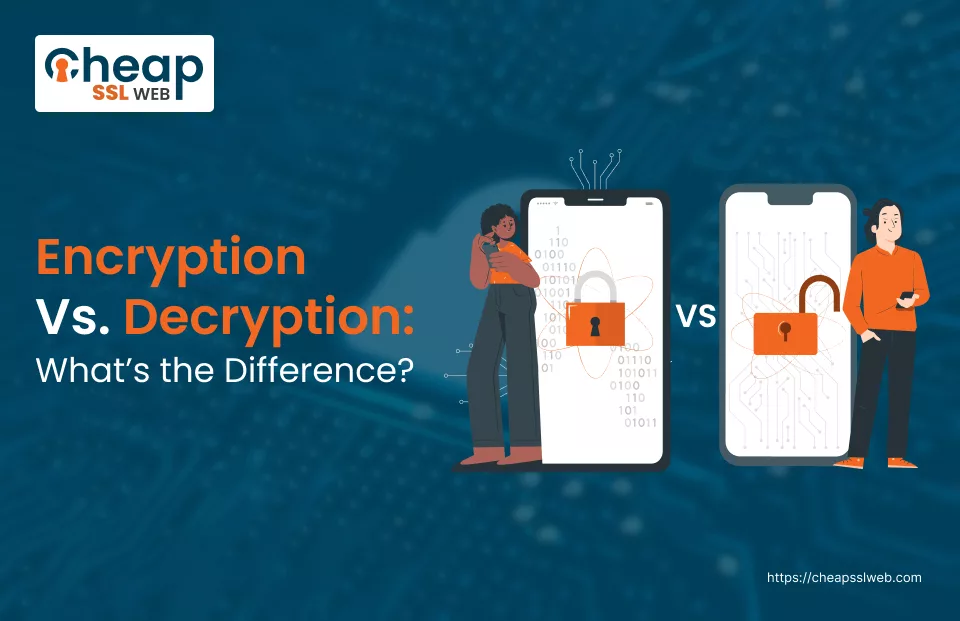Encryption Vs. Decryption: What’s the Difference?

What is Encryption?
Encryption refers to the act of converting raw, unencrypted, or plain data into an encoded form referred to as ciphertext such that it becomes unreadable to any unauthorized entity.
The main goal here is to transform the initial data using algorithms and keys into the bundle incomprehensible format.
Recommended: Symmetric Encryption vs Asymmetric Encryption
This way, if the encrypted data is taken and accessed unauthorized, it becomes incomprehensible and unrecognizable without the key for decryption. Encryption may be ubiquitous in order to secure sensitive data when it is stored, sent, or communicated.
It is the backbone of security as it helps in ensuring the privacy of the data in many realms that include online banking, secure messaging platforms, e-commerce, military communication and many others.
Applications of Encryption & Decryption
The applications of encryption and decryption are as follows:
Data Protection:
Encryption plays a crucial role in safeguarding data at rest, such as stored files and databases. By encrypting this data, even if it falls into the wrong hands, it remains unreadable and useless without the decryption key, preventing unauthorized access and data breaches.
Cloud Security:
Encryption is employed in cloud storage and services to protect data stored on remote servers. This ensures that even if there is a security breach or unauthorized access, the encrypted data remains confidential and unreadable without the proper decryption key.
Compliance with Regulations:
Encryption is often required to comply with data protection regulations and industry standards. For example, the General Data Protection Regulation (GDPR) mandates the encryption of personal data to ensure privacy and prevent unauthorized access.
Recommended: Encryption Vs Hashing Vs Salting – What’s the Difference?
What is Decryption?
The process of decryption is in a way the basis of the science of cryptography. It reactivates the operation that receives encrypted data, called ciphertext, and turns it into the original, readable form known as plaintext.
Encryption is a method that is used to protect important information’s from outsiders. On the other hand, in a situation where the encrypted data would still be needed, authorized individuals or systems will decrypt it in order to use it.
Decryption is the precise area where this occurs. Decryption entails the decoding of the data with the aid of a decryption key which is the mirror and exact opposite of the original encryption key or algorithm.
The decryption key runs the same function as the encryption but in reverse, putting the authorized party in a position to read the data that was previously scrambled.
Real-life Examples and Use Cases of Encryption and Decryption
Here are some real life examples of encryption and decryption:
Online Banking
In the online banking environment, encryption is the tool that you use to guarantee that your personal as well as financial data is secured.
Every time when you sign in using your bank account website or app, all transmitted information such as user name, password, and any other sensitive data are encrypted.
By means of this, legitimate actors are not able to compromise and access your credentials, as a result, you are able to protect the disclosure of your financial transactions.
Secure Messaging
These mainstream messaging platforms which include WhatsApp, Signal, and some others, make use of end-to-end encryption so as to ensure the privacy and security of your conversations.
In the process of sending a message, the message is encrypted on your device and only the recipient is able to decrypt it and read it. It makes sure that the emails are secure from being disclosed to those who have no authority and overhearers.
E-commerce Transactions
The encryption of online transactions is the most critical security factor. While you are putting an order on an e-commerce platform your credit card details are being encrypted during their transmissions.
Such encryption makes eavesdropping and gaining an access to your private financial information unimaginable, thereby giving online shopping a safer environment.
Cloud Storage
Cloud storage providers against data theft employ end-to-end encryption techniques.
For example when you upload files on Google Drive or Dropbox the data is encrypted before transmission and it stays encrypted while it is stored in their servers.
This means that if a penetration or unauthorized access occurs, the data can be encrypted and will be unreadable without the code key.
Military Communications
Encryption is one of the most widely used methods in military and defense communications for ensuring that confidential information remains safe.
The military field utilizes the latest encryption algorithms and methods to prevent its communications from getting compromised by eavesdropping or unauthorized access.
That makes sure that confidential and restricted information is not compromised and therefore remains out of reach of adversaries.
Difference between Encryption and Decryption
| Aspect | Encryption | Decryption |
| Definition | The process of converting plaintext into ciphertext to prevent unauthorized access. | The process of converting ciphertext back into plaintext to make it readable again. |
| Purpose | To protect data from unauthorized access during storage or transmission. | To restore encrypted data to its original, readable form for authorized users. |
| Input | Plaintext (readable data) | Ciphertext (encrypted data) |
| Output | Ciphertext (encrypted data) | Plaintext (readable data) |
| Algorithms Used | Symmetric algorithms (e.g., AES, DES) or asymmetric algorithms (e.g., RSA) | Same algorithms used in encryption (e.g., AES, DES for symmetric, RSA for asymmetric) |
| Key Usage | Uses an encryption key | Uses a decryption key |
| Security Goal | Confidentiality | Data accessibility for authorized users |
| Typical Applications | Securing data at rest and in transit, ensuring privacy | Accessing and using encrypted data, secure communications |
| Process | Involves transforming data using cryptographic algorithms and keys | Involves reversing the encryption process using cryptographic algorithms and keys |
| Computational Requirement | Requires computational power to transform plaintext into ciphertext | Requires computational power to transform ciphertext back into plaintext |
Conclusion
When you want to secure your site, you can get an SSL/TLS certificate from CheapSSLWEB that gives your site powerful encryptions. These certificates provide maximum protection to your online data and privacy by safeguarding your critical information on the internet.
Recommended: Encoding Vs. Encryption: Explaining the Difference
